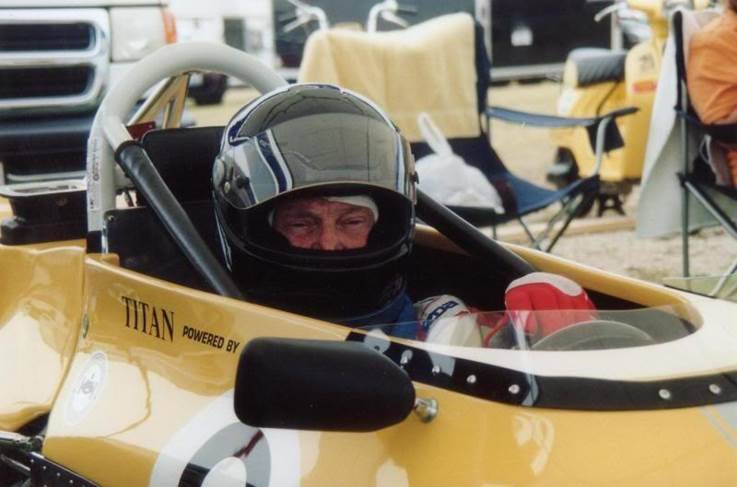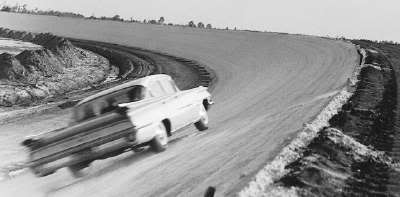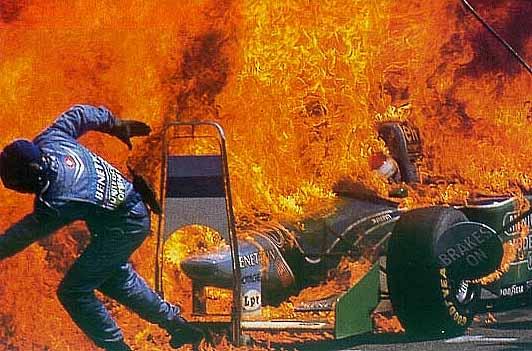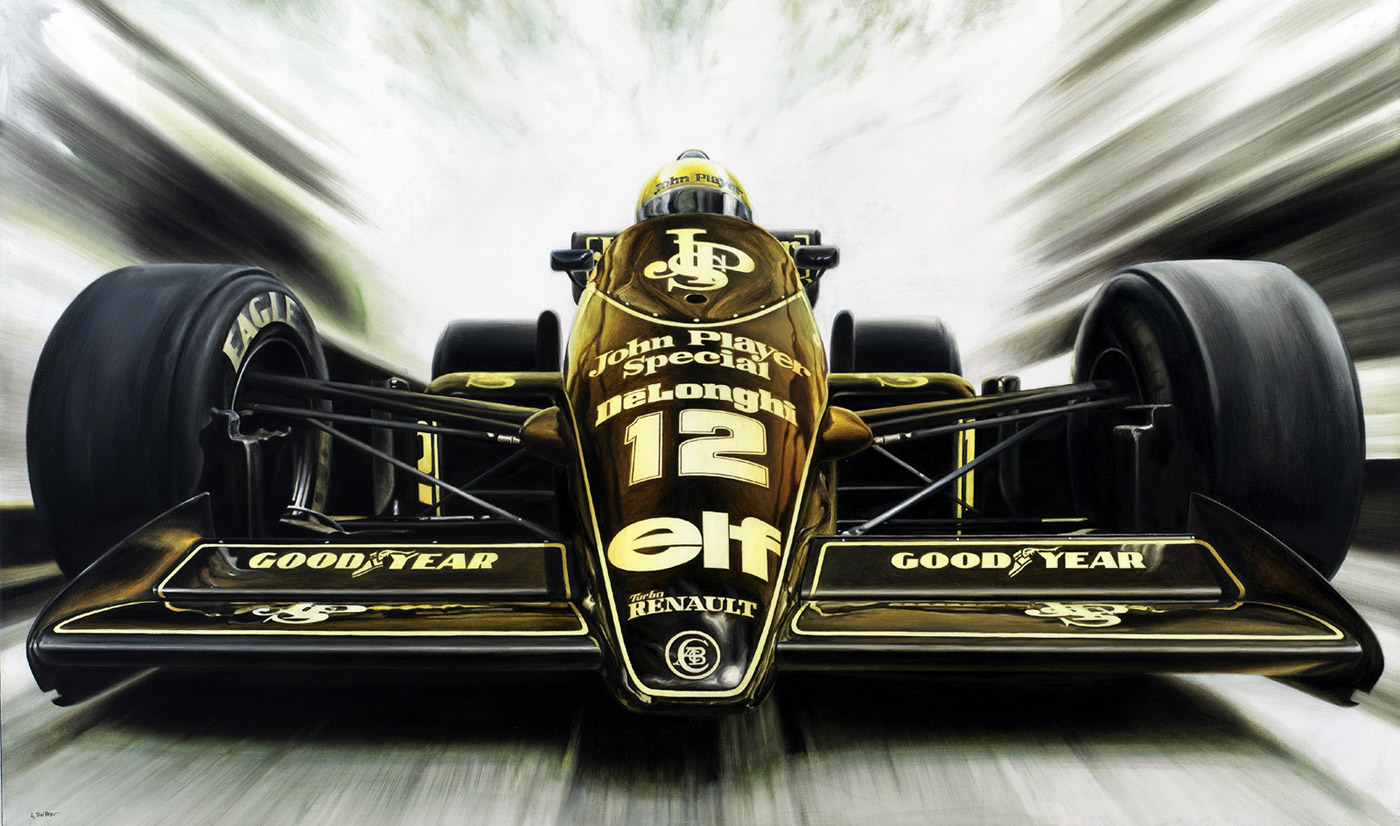Jonathan Summers is a teaching assistant and guest lecturer at Stanford University. He’s an independent automotive historian, podcaster, blogger and Pebble Beach docent. A lifelong car and motorcycle enthusiast. Mr. Summers’ recent work has focused on historiography in motor racing, delving into not just what happened, but how these stories were preserved, by whom and why. From text and still photography through television and now to YouTube, Goodwood and Gran Turismo, his presentation examines the evolution of the methods in which the stories of motor racing have been told and the history preserved.
Notes
Swipe left or right (or use the arrows/dots) to navigate through the presentation slides.
Transcript
[00:00:00] Brake Fix’s History of Motorsports series is brought to you in part by the International Motor Racing Research Center, as well as the Society of Automotive Historians, the Watkins Glen Area Chamber of Commerce, and the Argettsinger family. Midget and big car racing in the San Francisco Bay Area from 1945 to 1951.
Learnings from the Lapuchette Archive by Jonathan Summers. John Summers is a teaching assistant and guest lecturer at Stanford University. He’s an independent automotive historian, podcaster, and Pebble Beach docent. The chance gift of a small magazine archive to the SAH led Summers to research midget and sprint car racing during the immediate post war period around his adopted home of the San Francisco Bay Area.
This grassroots history charts the rise of great names in racing such as Curtis and Volkovich, and yet was over in under a decade. Less than a century later, no trace of the tracks remain. And John’s presentation offers a glimpse into this already lost world. [00:01:00] Jonathan Sommer, he’s going to talk about midget and big car racing in the San Francisco Bay Area, 1945 to 51.
It’s learning from some archives that he came across. Jonathan, whenever you’re ready. The Society of Automotive Historians was gifted a remarkable archive of magazines collected by a San Francisco Bay Area based racing fan. I picked them up on behalf of the Society and I asked Bob Barr, S. A. A. ‘s predecedent, What should I do with these?
Tell us what’s in them, he replied. The archive is a snapshot into post war racing in those few years before there was a TV in every home. It primarily covers midget and big car racing in the Bay Area. There are national titles too, early editions of Hot Rod Magazine and Motorsport, where in fact the first article in their very first edition is a report on the 1950 Watkins Glen Grand Prix.
In these early editions of Hot Rod, the customs, which are built for looks, mingle with the lake races, which are built only for speed. There’s an assumption of the reader as a [00:02:00] skilled or aspiring artisan. To draw value, careful reading and the time, inclination, and skill to be fixing or fiddling with cars is required.
This was an era when hot rodding was perhaps a little like drift culture is today, with a younger anti authoritarian demographic and sideshow like street takeovers for racing. This archive is the lens through which a car enthusiast in the late 40s and early 50s appreciated cars and auto racing. Dr.
David Lusko and others have examined the early history of hot rodding. Instead, my focus will be on the bulk of our archive here. The Bay Area Racing Journal Speed and the annual yearbooks put together by the same publishing team. These magazines aren’t just repositories of information, they’re artifacts in themselves.
The programs show that Mr. Lapichet was actually at the event and he’s even filled in the results. There’s one magazine that’s got a pit pass stuck on the cover of it that I’ve got a picture of. So I’m not a Sprint or [00:03:00] Midget historian, and so for me the research has been a pretty steep learning curve.
I’ve lived in the Bay Area for 18 years, although I’m not a Bay Area native, I’m English, if my accent was hard to place. The notion that a place like San Carlos, with its four, five, six million dollar houses now, should be somewhere Where you could race seems really quite strange, certainly race in a dirt oval kind of a way.
I’d heard a lot of the names before because I did a project 10, 15 years ago about the Carrera Panamericana and Lincoln’s team for the Carrera included Bill Vukovich, Johnny Mann, Chuck Stevenson, Walt Faulkner, these kind of guys that crop up a lot of the time when you’re reading about sprint and midget car racing in this period.
Key written sources which deserve special mention are Dick Wallen’s series of comprehensive histories of oval racing and Tom Motter’s work on the history of the Bay Cities Racing Association. Earl Motter was a midget racer. Tom, his nephew, has become a leading historian in the area. The [00:04:00] literature, Wallen in particular, gives the minutiae covered in the archive some sort of proper context.
In 1949, a movie called The Big Wheel was released, and it shows how much midget and sprint car racing was the zeitgeist of the age, or at least especially so in Southern California, Los Angeles movie town. It starred Mickey Rooney in, well in my opinion, a rather unremarkable plot and not really very good racing scenes, but the pit scenes do in fact feature a Silver Arrow pre war Mercedes Grand Prix car, so I didn’t feel as if my time was entirely wasted in watching the movie.
I also visited the Woodland Auto Display in Paso Robles, which is about four hours south of San Francisco. It includes four midgets from our period, and a Ford V8 Roadster, or jalopy, in addition to various big cars. The midgets are of different marks. So there’s one that’s made by a company called Solar.
They made planes as well, and it has a stainless steel chassis. shape the frame rails, those stainless steel. I found the museum very useful in [00:05:00] terms of showing the evolution of the cars from the late 40s to the early 50s. Terms like big car, jalopy, and roadster become much clearer to understand when the cars are there in three dimensions and you’re looking at them instead of them in some kind of grainy two dimensional image where the car’s two inches long.
My favorite exhibit was Bill Vukovich’s midget. It’s a drake. He used it in the 30s. They had wider tires and were a bit lower by the 40s and into the 50s. They really looked more like 50s and 60s sprint cars. Want to draw attention to this, those of us who’ve been around racing cars are quite familiar with this, but if you’ve not, it’s really a shocking thing.
The shift levers between your legs. And I wonder if you were meant to change gear whilst keeping the thing in the drift. Your right hand was on the shift lever and your left hand was holding it in the drift. Or did you just get it up in top gear and did you just slide it and have both hands on the wheel?
I, I don’t know, but I thought that was worth highlighting as a way of making these vehicles come alive. And I guess what I wanted to say is that the TLDR is that midgets [00:06:00] and jalopies were around before the war, but the scene really exploded in popularity immediately after World War II in the late 40s.
And the jalopy seemed to have given way to the midgets, which in turn gave way to big car strokes, what became known as sprint cars and hard tops, which of course leads us towards NASCAR and that kind of stock car racing. The Lappachet archive covers a five year window with this general sort of evolutionary trend.
There’s adverts in these magazines, and they tell you where you can go and buy Hot Rod Parts. You’ve got Edelbrock’s Place in Hollywood, advertised the same place as a plumbing supplier in Daly City up here in San Francisco, advertised on the same page as this address here, 4720 Geary Boulevard, which is about, I don’t know, three minutes drive from where I’m sitting here in San Francisco.
This is where you could buy a Curtis midget. This is probably where Vuki came to buy his midget in the post war period. Shiatsu massage is, is what takes place there. And [00:07:00] the reason why I’m emphasizing this is that the most striking thing about investigating this archive is where the racing took place has completely changed.
Racing tracks tend to spring up on the edge of town where land is cheap. As the town grows, that land is no longer on the edge of town or cheap, and pressure grows for it to be repurposed. This is what happened to Riverside in Los Angeles. Tom Motter’s book on the Oakland Stadium shows in detail how this process happened in the Bay Area too.
Taking just the midgets, the variety and sheer number of racetracks was enormous, with indoor and outdoor quarter mile or five eighths of a mile tracks, banked and flat, different surfaces paved and dirt. Old venues disappeared and new ones sprang up regularly. In 48 and 49, the midgets raced on nine tracks within a two hour drive from San Francisco.
So that’s racing every night. Nine tracks within a couple of hours of where I’m sitting in at the moment. Today, no trace of any of those tracks remain because, of course, it became prime [00:08:00] Silicon Valley real estate and those multi million dollar homes got built on the spot. So I guess what I’m saying here is, is that many of us will remember Netscape, Nokia, those of us who are a little older may even remember the era of disco.
This was the midgets. There was nothing. Then they came. They were enormous. They were the talk of the town. And then they went, all in quite a brief period. The drivers and their world really come alive through this archive. There are a surprising number of photos of drivers, and it’s true that this kind of magazine was the only media for the audience to get to know the drivers.
So no TV, no radio, nothing like that, only these magazines. Newspapers, but not this level of detail. A contemporary British magazine such as Motorsport in this period, published few photos in this way. And in an era of Drive to Survive like docu series. It’s interesting that the BCRA and Speed were really plugged in.
They knew 70 years ago what drew fans in. The other draw played upon in the archives are what are [00:09:00] referred to as the thrills and spills of racing. I mean, that’s to say it’s the crashes and the injuries and the fatalities that we’re talking about here. And some pretty unflinching, even salacious reporting of these incidents.
It’s a very noticeable feature of the archive, and one which is quite jarring to 21st century eyes. In one May 1949 edition, a leading driver in a race is flung from his car onto the track, and narrowly avoids being run over by the field. In another incident, a driver is described as having his throat cut.
In one 1949 edition, a fatality is mentioned on the cover, juxtaposed with the race winner. So you’ve got like, this dude won the race, this dude, he didn’t make it. These incidents were frequent because the small, tight tracks led to very close racing. Midgets could easily roll over and none were fitted with roll bars.
It was seen as very much part and parcel of the racing spectacle. This is a blood sport and the drivers are eulogized in gladiatorial terms. Despite this attitude, there are some concessions to safety. Helmets were [00:10:00] compulsory. However, the contrast with British attitude is striking. When Mike Hawthorne, the first British Formula One world champion driver, was killed in a road accident a few months after he retired, the story and his obituary were buried deep in the pages of motorsport.
The run of speed is nearly complete, and each issue lists championship standings, race results, lap times, the car owner, the chassis, and the engine. And as such, it’s possible to really drill down on individual drivers and answer questions such as, Was Driver X underrated? Overrated? When did Offy Motors take over from the Ford V860 or the Drake V Twin?
The rise of Curtiss is documented in lap times and individual race wins. Lap times 10 seconds inside the previous lap record are not unknown and that speaks to the pace of technological development in the midget series. It also probably speaks to the fact that the circuits were changing all the time so that banking may have been higher this week than it was last week or it may have been [00:11:00] that you decided to run discovered nitromethane and were running it and the other guys weren’t.
This was the kind of technological development. So my research wasn’t that thorough, but it did reveal that there are pretty significant differences between an Ed Normie or a Jerry Piper, a regular frontrunner at the BCRA local series, and somebody like Fred Agabashian, who was a constant winner. In this local BCRA series, he was major champion in 47, 48, and 49.
Significant difference between them and the traveling celebrities, guys like Johnny Mance and Bill Vukovich, who raced all over the country. And I’ve just, I’ve tried to do this like a medieval. Piece of stained glass, right? Where the important guys and the big names, they’re biggest. So here’s Jesus, Bill Vukovich.
So he’s the biggest guy. And then, you know, the bishops and so on the traveling celebrities. We’ve got Johnny Mance and Johnny Parsons up on the top left. And then in the bottom, right, we’ve some guys that maybe would win when they came to the area. There’s Raho Jack in the bottom [00:12:00] left and Edgar Elder in the middle there, who was a local guy who built cars as well as race them.
The BCRA yearbook talks about fans having to decide whether to cheer or jeer Bukovic on to yet another win. The archive, therefore, provides a real sense of the pyramid of racing, with Indy at the top and the local racing that we’re talking about here as a rug on the ladder. A spectator at a Bay Area track would have known that success here was a stepping stone to the biggest motor race in the world by birth.
In an edition of Speed from February 1951, it’s reported that there were so many happenings that the timekeeper gave up, reminding us that this is still a young sport, an amateur endeavor. Yet a scan of the entry list over the page shows that about half the entrants have sponsors, and some of the names, Bardald, Offenhauser, Curtis, sound ready for Indianapolis.
The reader can feel just how much the sport is on the cusp of professionalism. Equally, the traveling celebrities, Buki, Mance, Parsons, were obviously able to make a living by traveling in this [00:13:00] way, even as the dominant local driver, Aggie there in the bottom left, still had to have a day job selling Cadillacs, or at least that’s what he did according to the advertising in Speed.
Turning to Speed Magazine itself, its very existence reveals the nature of racing in the Bay Area in the late 50s. There was racing in the Bay Area every night of the week so that even the dedicated race fan could not hope to make every meeting. The frequency of races meant that Speed had to be produced weekly, with fans needing to take the magazine to learn what happened at other races that week before the circus arrived back at their local track once more.
For Context Travel from San Francisco to tracks in Lodi or San Jose was two hours each way. Race reports follow the same structure. A sum up and results in the first paragraph, crashes and incidents in the second and a detailed race descriptions spread over paragraphs three and four. Early editions have a section entitled Goggle Gossip, full of tidbits of information about the driver’s personality, their [00:14:00] superstitions, their favorite food, the names of their wives and children.
Surprisingly, the tone is similar to a 21st century gossip rag, the ones that you find at supermarket checkouts, you know, Us Magazine and People Magazine, those kind of things. Editions from mid 1949 asked for volunteers to quote Cover the races in your town or vicinity if, quote, you have a secret yen to be a writer.
And in that sense, it’s almost like a modern interactive blog or forum or Facebook where readers are asked to contribute content. Later editions have coverage of auto racing in the Los Angeles area and stories about the sport nationally, especially Indianapolis. As content developed, the number of staff involved in producing the magazine grew and the quality of paper it was printed on improved.
BCRA yearbooks give far more detail, providing necrologies of the top drivers, pictures of them in their car, headshots, and the kind of details which imply that face to face interviews must have taken place. One of my undergraduate tutors was [00:15:00] Dr. Ian Wood, a leading thinker about the early medieval period.
In trying to explain the sources he worked with, he used the metaphor of a plane flying above clouds on a summer’s day. Where there is a cloud, we in the plane cannot see the ground at all. However, where there is a break in the cloud, the sun shows the fields, the hedgerow, the crops, the farmers at work, all in perfect detail.
For him, medieval history was like this. For me, this archive has been that break in the cloud, a moment of perfect illumination of a period of racing history I knew nothing about previously and which has been largely forgotten. Vukovic is of course the name which is most memorable from my research, but really the biggest story of the archive is the detailed documentation of the early days of Curtis.
Whose cars will win the Indy 500 with Johnny Parsons in 1950, Lee Waller in 1951 and Bill Vukovich in 1953 and four, and Bob Schweiker in 1955. I’ve [00:16:00] explored this very rapid development in the use of land when looking at other elements of racing and motoring history, for example, many of you will have heard of the Yanko Kamara.
You probably don’t know, but Dana Chevrolet in Los Angeles were fitting 427s to Camaros before Don Ianco in Pennsylvania. My wife is Dana. It seemed only natural to visit Dana Chevrolet, except there’s no trace. Not only has the dealership gone, but so has the building. In fact, as far as I could discern, As of 2015, not one of the buildings on the four way intersection where Dana Chevrolet stood in 1968 in Los Angeles, not one of those buildings remains.
And much of this is a function of California and the West Coast. We have earthquakes, we build from wood and stucco, not bricks and mortar. However, it’s a phenomenon which I’ve seen elsewhere. Some years ago, I presented a paper at this conference about Mike Hawthorne, British Formula One world champion who was killed in that car crash in southern England in January 1959.
In the years since the accident, [00:17:00] not only is the exact location of the tree that he hit now impossible to discern, but the road direction has been reversed, then the carriageways have been split, and the whole landscape has been gently remodeled. But what does that mean? Well, the people are dead and gone.
The land has changed beyond recognition, but the cars and the magazine archive, they remain to tell us their story. Luckily, the magazines are accessible, the stories are dramatic, the photos are compelling. The cars with their noisy smelly motors and the gear shifting conveniently between the driver’s legs and the visceral driving characteristics that they have, that all sits dormant in a museum.
And that Plus this archive that ensures that this brief era of racing history will keep its place in posterity despite this new, safe, televised, electrified future which we are rushing towards. Thank you very much. Let me know if you have any questions please. So where do [00:18:00] those magazines reside and are they being digitized and available on the internet?
They’re sitting on a shelf about six feet away from where I’m sitting at the moment. The guy’s daughter was going to throw them away and contacted the S. A. H. and I was local, so that’s how I acquired them. So, no, no plans to digitize at the moment. John had a, uh Rendezvous in a hospital parking lot, right?
Where she worked? Yes. In fact, the park at the hospital is on Geary Boulevard, so I drove past Frank Curtis’s Northern California location on the way to go and pick up the magazines. They’re in safekeeping. Was Danny Foster Sr. a part of the San Francisco midget racing scene at all? That is not a name that I’ve run across in the archive.
I’ve limited myself what we were given. And it seems to me as if Lapachat, it seems to me as if he was really into it for the late 40s, and then by 51 or 52, he [00:19:00] wasn’t collecting anymore. Thank you, John. Pretty fascinating what you’ve done with that collection. Uh, Pat Young says you really look like you’ve gone hippie on us now.
I mean, I told her it was just the bikes. Thank you, John. We appreciate it always. You’re always welcome.
This episode is brought to you in part by the International Motor Racing Research Center. Its charter is to collect, share, and preserve the history of motorsports, spanning continents, eras, and race series. The Center’s collection embodies the speed, drama, and camaraderie of amateur and professional motor racing throughout the world.
The Center welcomes serious researchers and casual fans alike to share stories of race drivers, race series, and race cars captured on their shelves and walls and brought to life through a regular calendar of public lectures and special events. To learn more about the Center, visit www. racingarchives.
org. This episode is also brought to you by the Society of [00:20:00] Automotive Historians. They encourage research into any aspect of automotive history. The SAH actively supports the compilation and preservation of papers. Organizational records, print ephemera and images to safeguard, as well as to broaden and deepen the understanding of motorized wheeled land transportation through the modern age and into the future.
For more information about the SAH, visit www. autohistory. org.
We hope you enjoyed another awesome episode of Brake Fix Podcast brought to you by Grand Touring Motorsports. If you’d like to be a guest on the show or get involved, be sure to follow us on all social media platforms at GrandTouringMotorsports. And if you’d like to learn more about the content of this episode, be sure to check out the follow on article at GTMotorsports.
org. We remain a commercial free and no annual fees organization through our sponsors, but also through the generous support of our fans, families, and friends [00:21:00] through Patreon. For as little as 2. 50 a month, you can get access to more behind the scenes action, additional Pit Stop minisodes, and other VIP goodies, as well as keeping our team of creators Fed on their strict diet of fig Newtons, gumby bears, and monster.
So consider signing up for Patreon today at www. patreon. com forward slash GT motorsports, and remember without you, none of this would be possible.
Livestream
This episode is sponsored in part by: The International Motor Racing Research Center (IMRRC), The Society of Automotive Historians (SAH), The Watkins Glen Area Chamber of Commerce, and the Argetsinger Family – and was recorded in front of a live studio audience.
Other episodes you might enjoy
Seventh Annual Michael R. Argetsinger Symposium on International Motor Racing History
The International Motor Racing Research Center (IMRRC), partnering with the Society of Automotive Historians (SAH), presents the Seventh Annual Michael R. Argetsinger Symposium on International Motor Racing History. The Symposium established itself as a unique and respected scholarly forum and has gained a growing audience of students and enthusiasts. It provides an opportunity for scholars, researchers and writers to present their work related to the history of automotive competition and the cultural impact of motor racing. Papers are presented by faculty members, graduate students and independent researchers.
The history of international automotive competition falls within several realms, all of which are welcomed as topics for presentations, including, but not limited to: sports history, cultural studies, public history, political history, the history of technology, sports geography and gender studies, as well as archival studies.
The symposium is named in honor of Michael R. Argetsinger (1944-2015), an award-winning motorsports author and longtime member of the Center’s Governing Council. Michael’s work on motorsports includes:
- Walt Hansgen: His Life and the History of Post-war American Road Racing (2006)
- Mark Donohue: Technical Excellence at Speed (2009)
- Formula One at Watkins Glen: 20 Years of the United States Grand Prix, 1961-1980 (2011)
- An American Racer: Bobby Marshman and the Indianapolis 500 (2019)





















